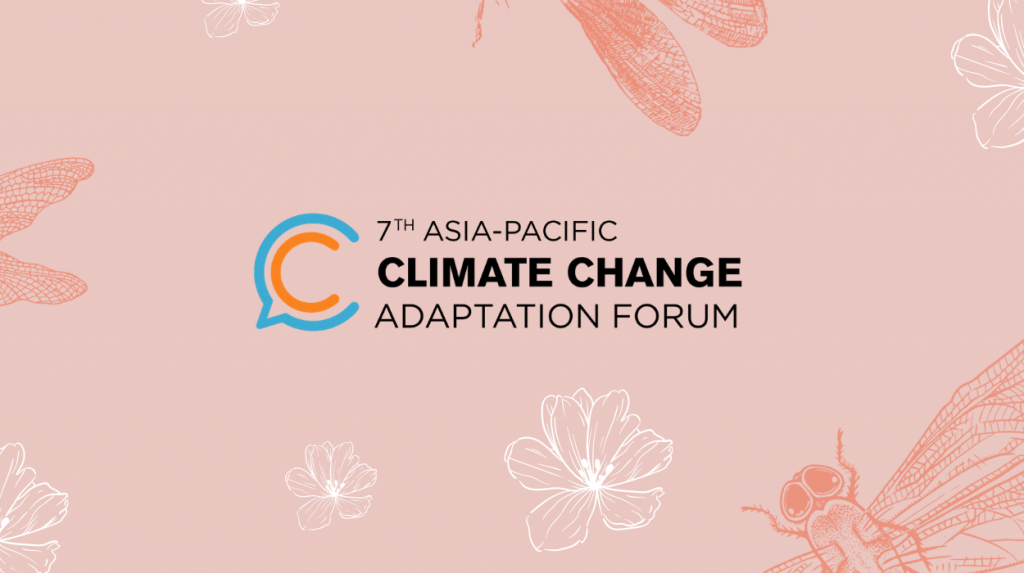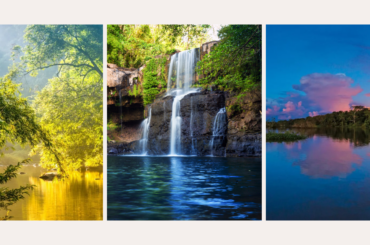After several postponements due to the COVID-19 pandemic, many outstanding international environmental events finally took place in early 2021, including the 7th Asia-Pacific Climate Change Adaptation Forum. With a total of 5 working sessions from March 8 to 12, a series of solutions were presented to scale up the mechanisms to build climate resilience, limiting the negative impacts of climate change to vulnerable countries. It’s been a year since these solutions were put into practice, and it’s time to find out whether all the expectations and goals set after the 7th APAN Forum have been met.

About the 7th APAN Forum
Asia-Pacific Climate Change Adaptation Forum (APAN Forum) is a regional platform established by UNEP in 2009. The purpose is to create a space for scientists, financing institutions, youth, adaptation practitioners, non-governmental organizations, and government agencies to meet, share and discuss practical climate change solutions and actions.
From 2010 to the present, the 7th APAN Forum and 1 APAN Virtual Dialogue Series have taken place with the joining of over 50 countries. The 7th Asia-Pacific Climate Change Adaptation Forum was originally scheduled to take place for four weeks in October and November 2020, but it was postponed due to the COVID-19 pandemic. Only until March 2021, when the pandemic was somewhat less complicated, the Ministry of the Environment Japan (MoEJ) together with the APAN Secretariat decided to hold the event virtually from the 8th to the 12th.
The main objectives of the 7th APAN Forum are to address the knowledge, policy, and funding gaps in the region, as well as expand current efforts and create the basis for the Asia-Pacific region’s contributions to the COP 26 taking place in Glasgow, United Kingdom in 2021.
The 7th APAN Forum After A Year – Are Things On The Right Track?
With the theme of “Enabling Resilience for All: The Critical Decade to Scale-up Action”, the 7th APAN Forum’s working sessions focus on 4 main thematic streams: Inclusive Resilience, Nature-based Resilience, Economic Sector Resilience, and Community and Local Resilience. This review is made around the above aspects, helping you to cover all the achievements and areas for improvement of the 7th APAN Forum.

Inclusive Resilience
There are significant bright spots in terms of finance and investment in building resilience and inclusion after disasters, as a lot of funds and investment projects have been approved in order to improve the Asia-Pacific region’s climate resilience and adaptation.
A series of typical projects from organizations such as the Green Climate Fund, the Global Environmental Facility, and the Asian Development Bank with the total value of up to billions of dollars have been approved in 2021, aiming to integrate biodiversity and address financial barriers in urban and green economy development, providing the foundation for building climate resilience in vulnerable countries.
Despite all these bright spots, there is also a problem worth noting about these projects and investments that prevents vulnerable countries from receiving the support they need. One of the goals of the 7th APAN Forum is to engage and facilitate vulnerable groups to reach sources of funding, ensuring that all their problems and concerns about climate change and building climate resilience are being taken care of. But reality has shown that although governments and organizations are really putting efforts to achieve this goal, it doesn’t seem to be enough.
Although a great deal of funding and investments for vulnerable countries have been launched, most of them are in fact provided not in the form of grants, but loans. This can help build inclusive resilience across the region in the early stages, but not in the long term, as these loans would make it difficult for indebted countries to maintain their inclusive resilience.
Nature-based Resilience
The 7th APAN Forum has emphasized the need to integrate actions to protect and restore natural ecosystems (also called Nature-based solutions) in order to benefit and improve both biodiversity as well as human adaptability to climate change.
On the integration and scaling up nature-based solutions for resilience in the Asia-Pacific region, a lot of programs on building resilience based on natural solutions have been promoted by regional organizations such as the Association of Southeast Asian Nations (ASEAN), the Bangladesh, Bhutan, India, Nepal Initiative (BBIN), and the South Asian Association for Regional Cooperation (SAARC). These programs have helped a lot in amplifying and enhancing local knowledge of effective Nature-based Solution practices, providing regional initiatives in order to raise awareness, and conducting vulnerability assessments to strengthen resilience as well as adaptability to climate change.
After 1 year of the 7th APAN Forum, statistics have proven that countries in the Asia-Pacific region have been making great efforts in order to play their role in the best way. A lot of Nationally Determined Contributions (plans for climate action – NDCs) from all Asia-Pacific countries have been submitted to the UN Climate Change Conference of the Parties, including solutions to reduce greenhouse gas emissions, as well as adverse impacts of natural disasters caused by climate change.
According to reports from the APAN Forum, 79 countries have declared in their NDCs that coastal ecosystems and biodiversity are vulnerable and put in place appropriate adaptation solutions. However, only 58% of the NDCs submitted come with credible commitments on Nature-based Solutions such as mangrove restoration, species conservation, or building seawalls. 58% is not a small number, but considering all the challenges we’re facing, as well as all the expectations from the beginning of the event, we need more consensus than this.
Economic Sector Resilience
The 7th APAN Forum has created a solid foundation for Asia-Pacific countries to promote resilience of agriculture as well as urban resilience in economic development. A series of smart agriculture practices have been put into application in many countries such as China, India, South Korea, Japan, etc., helping to strengthen the resilience of these countries’ agriculture to climate change.
Urban areas – hot spots of climate and disaster risk – are gradually improving in terms of climate resilience thanks to the innovative approach systems shared and agreed upon after the event. A lot of solutions on strengthening climate resilience on the basis of comprehensive development of environmentally sustainable cities. Nature-based initiatives such as the Sponge City in China or urban rooftop farming in Chennai, India are showing clear results in improving urban drainage and reusing rainwater, helping to cope with heatwaves, droughts, and floods.
However, a minus point in the operationalization of these climate policies in the economic field is that their application at the system level is still limited. The vast majority of these policies are only at the national level, but in order to address global climate change, more macro-level decisions at the global and regional levels need to be made.
Besides, the problem of expanding adaptation finance is also another challenge that the Asia-Pacific region hasn’t been able to absolutely solve. Although more than 600 billion dollars have been poured into this region’s climate sector since 2017, only around 5% has been earmarked for adaptation finance, which is not enough to meet the region’s huge needs.
By 2030, it is estimated that the annual cost of climate adaptation could go up to 300 billion dollars, 10 times the current amount of money spent on this sector. Therefore, in order to ensure long-term financial resources and create broader impacts, there have to be more innovative financial mechanisms to help the region to recover from the COVID-19 pandemic as well as scale-up nature-based solutions.
Communities and Local Resilience
2021 is the year to record the widespread use of technology in the Asia-Pacific region in assessing vulnerability and expanding the scientific knowledge about climate and ecosystems. Vulnerable countries like Indonesia or Tuvalu – with funding from environmental organizations – have been able to apply advanced technologies such as the “Vulnerability Index Data Information System” (locally known as SIDIK) or the LIDAR (Light Detection and Ranging) technology in the assessment of the vulnerability of different areas, making a significant step forward in building long-term climate resilience.
Another achievement that the 7th APAN Forum has harvested in 2021 is that the Asia-Pacific countries have been more serious about integrating the perspectives of local communities into key national development plans. This helps underrecognized classes to highlight their special needs and contributions to improve climate resilience.
However, due to the lack of specific mechanisms to inform local communities about global and national strategies and actions, as well as contribution and feedback mechanisms, the engagement of these groups in supporting climate adaptation is still somewhat patchy and lacks coherence.
Bottom Line
The Asia-Pacific Climate Change Adaptation Forum can be considered a successful event thanks to a lot of impressive achievements that it earned in 2021, as well as the positive contributions of the Asia-Pacific region at COP26. However, those achievements are not the ultimate goals, and there are still so many things we need to do in the future. A lot of organizations around the world are joining hands to make this journey less troublesome, and you can contribute even just a little by using Tenere to plant trees around the world while saving money. Solving the problem of climate change is not just an organization’s responsibility. The participation of individuals is also very important in order to keep things on track.





